The final matchday of the UEFA Champions League in group C saw Dinamo Zagreb play Manchester City. The visitors, under the guidance of Pep Guardiola, had already qualified for the knockout stages in the top spot and therefore rotated an already injury-hit squad. For Nenad Bjelica and his Dinamo Zagreb players, only a win would do. Dinamo needed to go all out to win the match and hope the result in the other group match swung their way. The match finished 4-1 to Manchester City, meaning Dinamo squandered any chance of qualifying in second place.
This tactical analysis will investigate how Dinamo Zagreb and Manchester City played via an analysis of match tactics. Specifically, the analysis will include information on offensive, defensive and transitional components of play from each team, as well as other key match events and stats.
Lineups
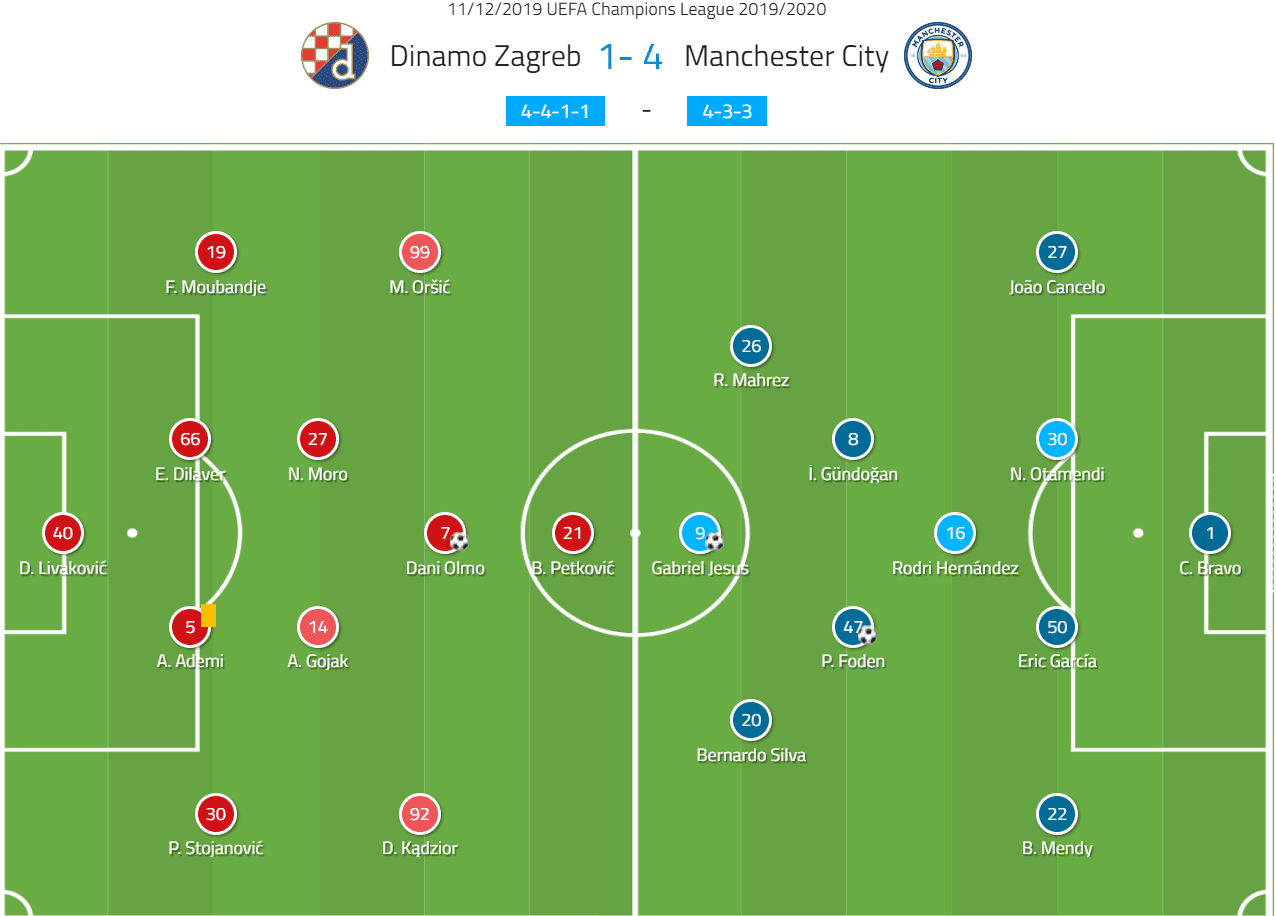
Both managers were forced into changes to their preferred Champions League line up. Dinamo Zagreb were without their two first-choice centre-backs and their starting left-wing back. This forced a formation change from a 3-4-3, also known as a 5-2-3, to a 4-4-1-1. For Manchester City, they had the personnel to play their traditional 4-3-3, but, given their first-place finish in the group, City did have the opportunity to start youngsters, Phil Foden and Eric García, whilst also rotating many other players who started in the Manchester derby.
Average positions and formations
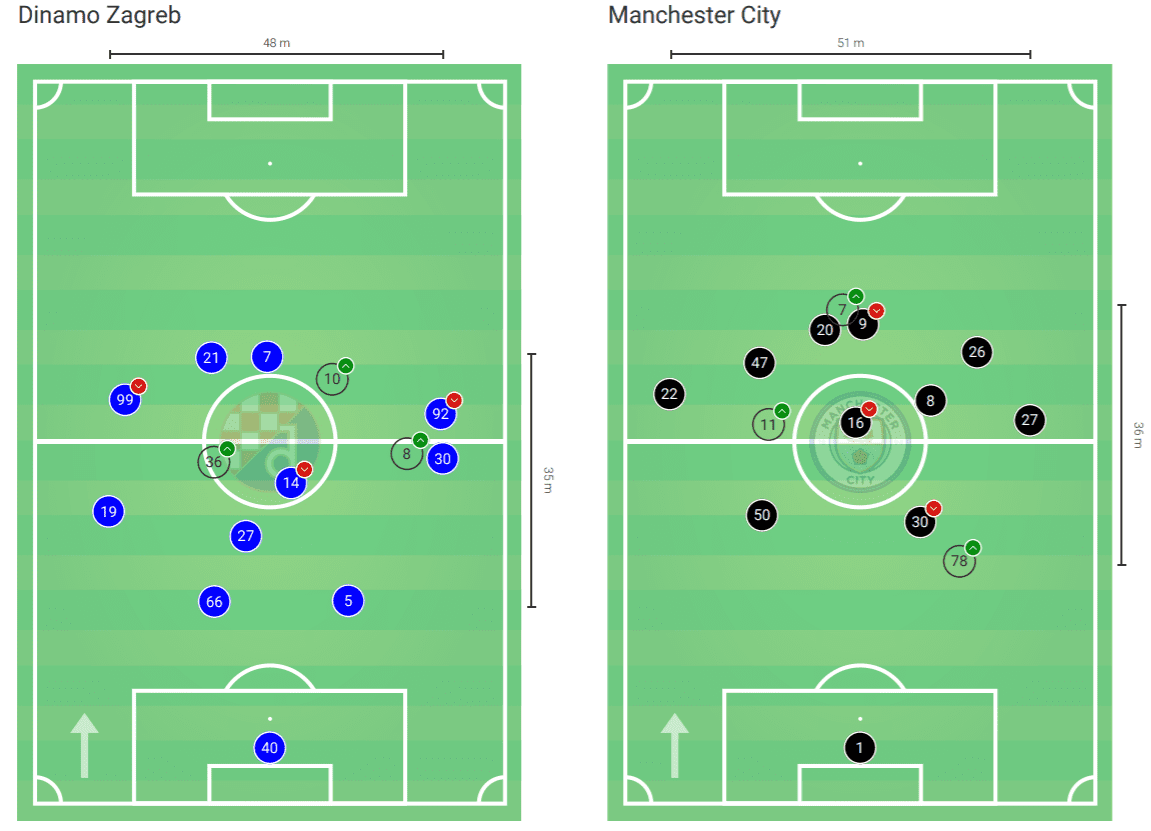
Both teams maintained their general shape throughout the match, with Manchester City dominating possession high up the pitch, but offering the positional rotation and flexibility that Pep Guardiola teams are famous for within the rough 4-3-3 shape. Dinamo Zagreb, who struggled to see much of the ball, can be seen playing on the back foot, with the majority of players deep in their own half. Although, Dinamo’s 4-4-1-1 on paper looks more like a 4-4-2 based on average positions, however, the second half changes mentioned below will have impacted upon this.
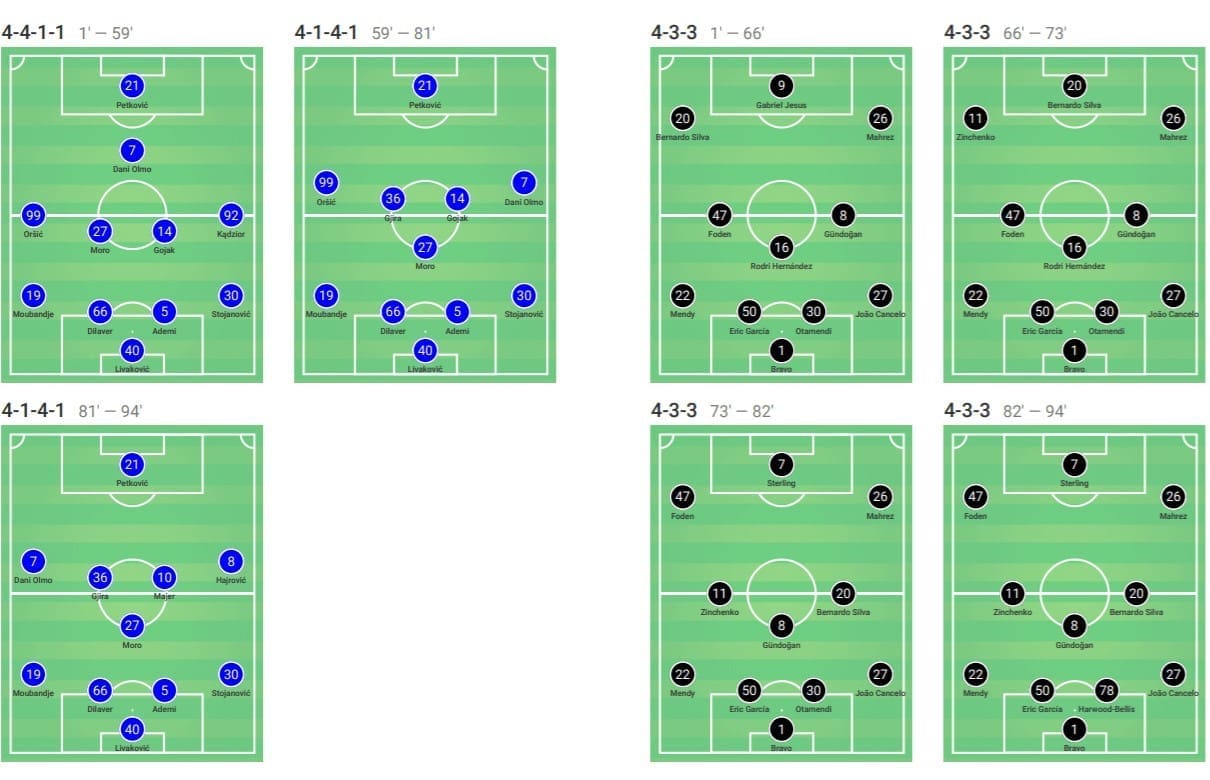
Manchester City retained their 4-3-3 throughout the match whereas Dinamo Zagreb dropped into a 4-1-4-1, a negative change which was a key feature of their second-half performance.
Match summary
Overall, this was a match Manchester City dominated. Despite numerous changes and the necessity for Dinamo Zagreb to win the match, the English champions displayed why they are revered as one of the best teams in Europe with a professional, successful display.
Nenad Bjelica’s Dinamo team did take the lead through an impressive volley and threatened down the flanks on a couple of quick counter-attacks, but, ultimately, their attacking prowess faded as the City dominance grew towards the end of the first half with the visitors scoring the equaliser. The strength of City continued to grow in the second half, combined with a Dinamo Zagreb drop off, City scored three more goals in a 4-1 win.
Gabriel Jesus took the headlines in the victory for the group C winners with a hat-trick. Foden and Benjamin Mendy also impressed throughout.
Match stats
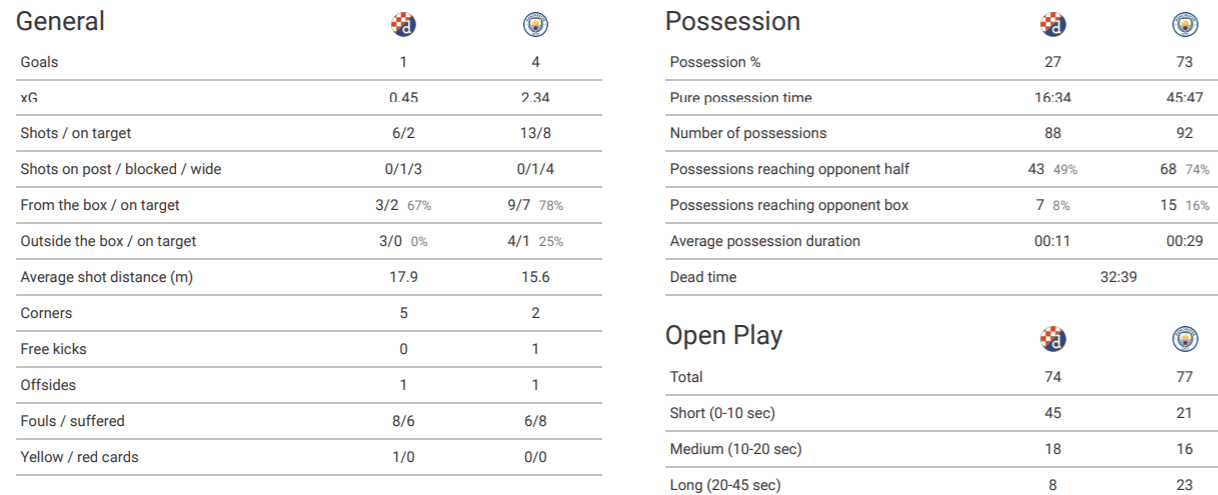
As the match stats suggest, Manchester City dominated the ball, showed more attacking threat and were able to convert the chances they created. Dinamo Zagreb finished with more corners, another match feature typically dominated by the visitors. This set-piece superiority is likely due to the wing-play Dinamo tried to accomplish in addition to 50% of their shots coming from outside the box.
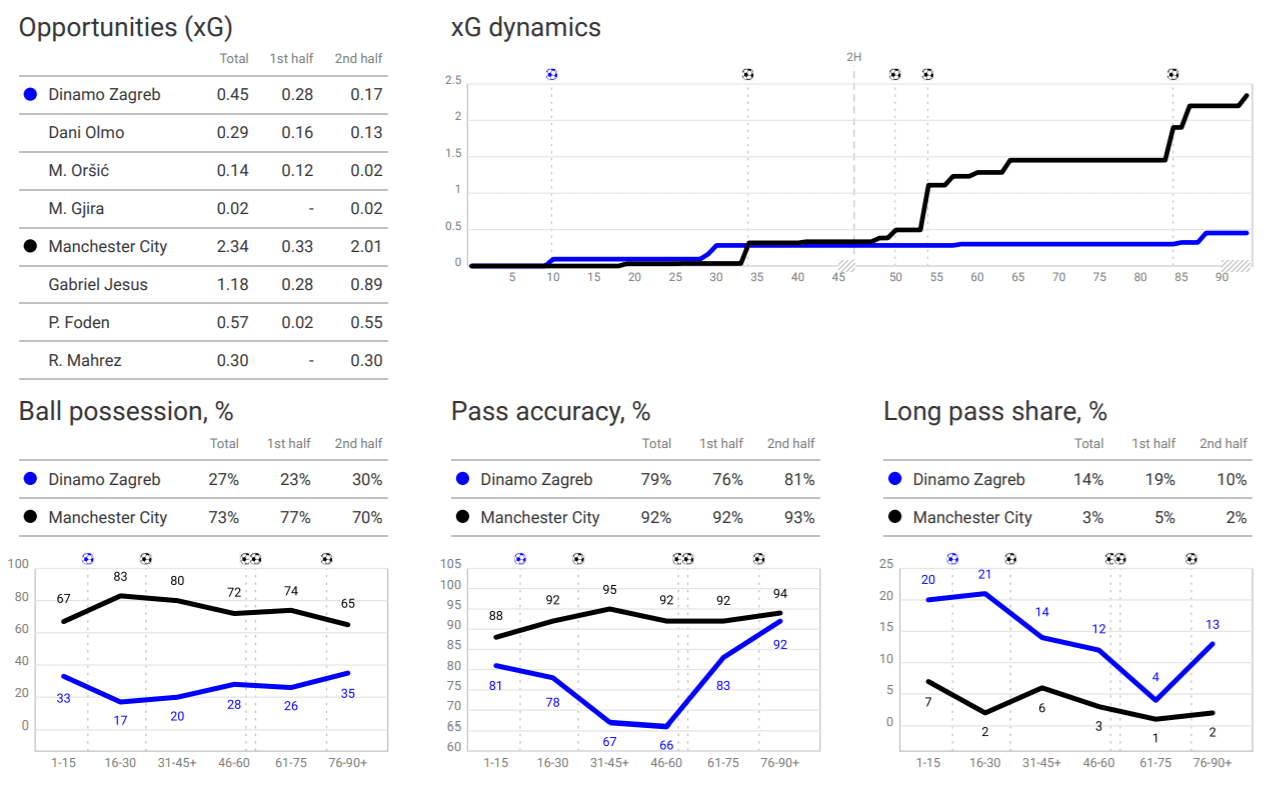
Looking deeper at the advanced metrics and the development of attacking features and styles, Manchester City created more chances, resulting in a higher xG and as expected, played more of their passes short when compared to Dinamo Zagreb’s more direct style.
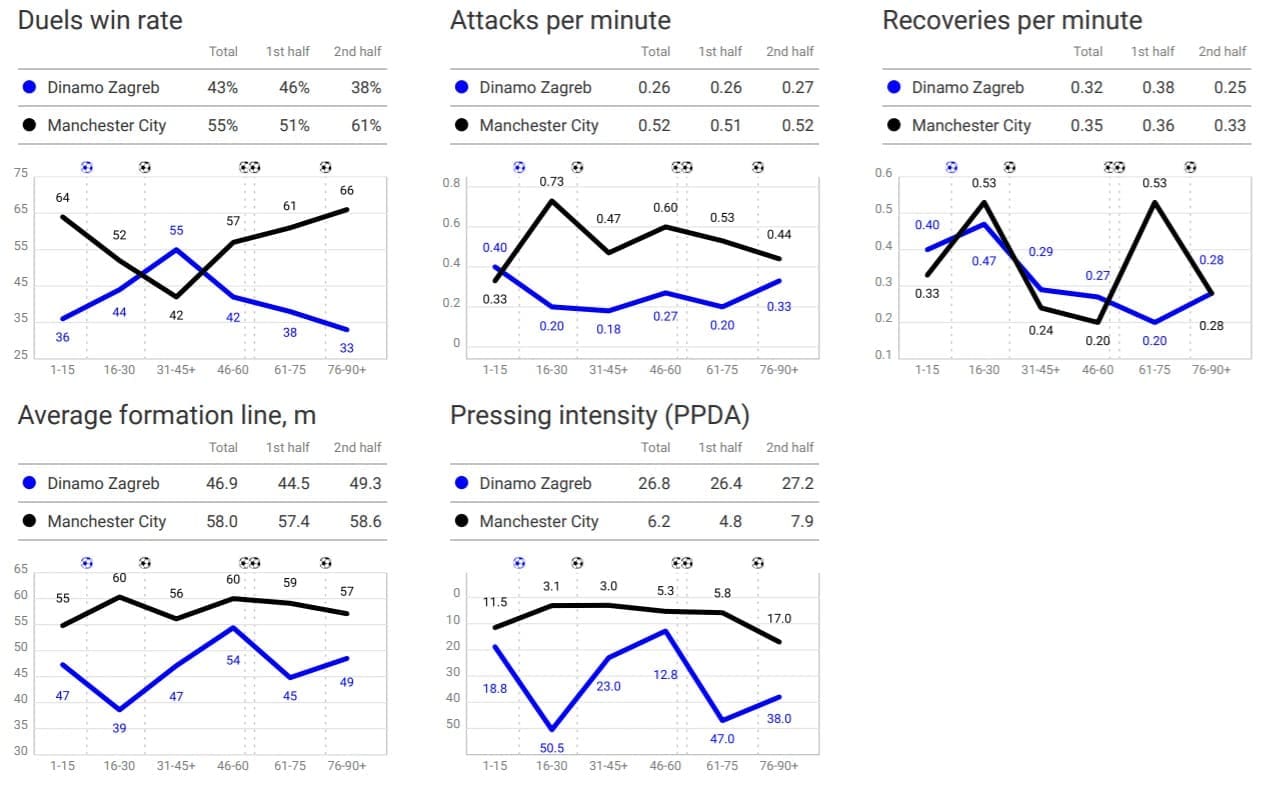
Dinamo couldn’t get the ball
Within the match, the home team had little possession, 27%, to be exact. Therefore, there were few long passing sequences from Dinamo Zagreb in an attempt to break down the Manchester City defence. On the whole, Dinamo had to rely on quick transitions or short possession sequences down the flanks, should an opening not arrive from the immediate attacking transition phase.
However, one of the longest passing sequences for Dinamo Zagreb resulted in their first goal. 11 passes were played in the build-up to Dani Olmo’s opening goal. Although, after the goal, Dinamo struggled to build up passing moves and resorted back to low-frequency passing sequences.
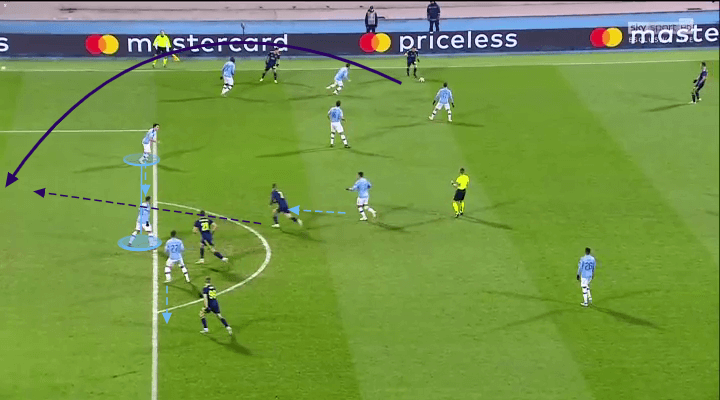
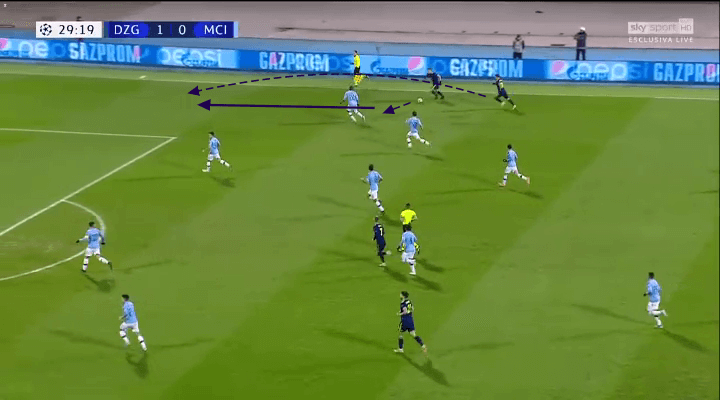
Manchester City dropped into a 4-1-4-1 out of possession early in the game, rather than utilising a high-press, or when the phase of play had beaten the press. Because of the congested central areas, Dinamo Zagreb aimed to work the ball out wide and rely on crosses into the box, rather than longer passing sequences which may involve short passes around the edge of the box. Dinamo did not have that luxury due to general technical inferiority compared to City’s players, their opponents shape, marking and the decision to surround the ball holder with three players in a triangular shape in order to suffocate play and win the ball back, such defensive work will be highlighted when discussing Manchester City’s defensive transitions and shape later. Dinamo Zagreb needed to get the ball wide and up the pitch fast in transition or more progressively if in controlled possession, for example, their goal, in order to look for avenues to play the ball into the box.
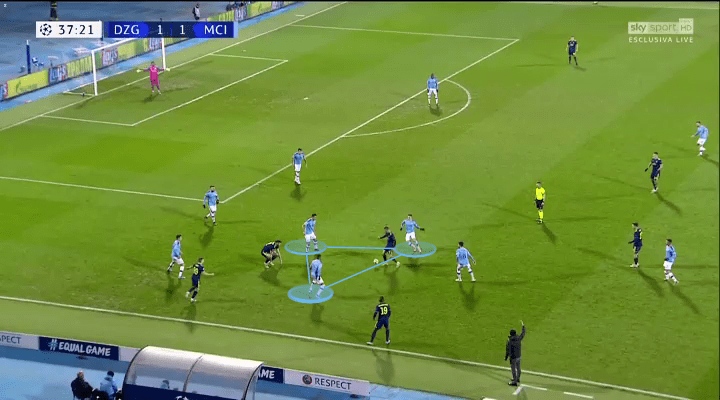
When Manchester City won the ball, they kept it
While we have discussed Manchester City in defensive transition and out of possession, when they did win the ball back they kept it. Their attacking transition was patient and controlled, focusing on maintaining possession and settling back into their pattern. The main reason for this is the deep out-of-possession structure Dinamo Zagreb regressed into when they lost the ball. Dinamo Zagreb did throw bodies forward within their attacking transitions early in the game, this sometimes presented space for Manchester City’s players to exploit quickly, but, given City dropped into shape, many players weren’t in perfect positions to exploit the space. Another reason why City decided to play a more progressive game in attacking transition was due to their personnel. Instead of the pacey, athletic wingers in the form of Raheem Sterling or the injured Leroy Sané, City opted to play Bernardo Silva and Riyad Mahrez. Therefore, there was a lack of pace in wide areas. Whilst the flanks were stretched by the full-backs in general play, given the tendency of Mahrez and Silva to cut inside whilst playing on opposite wings to their strongest foot, when the visitors dropped into their 4-1-4-1 shape, the full-backs retained a deep position.
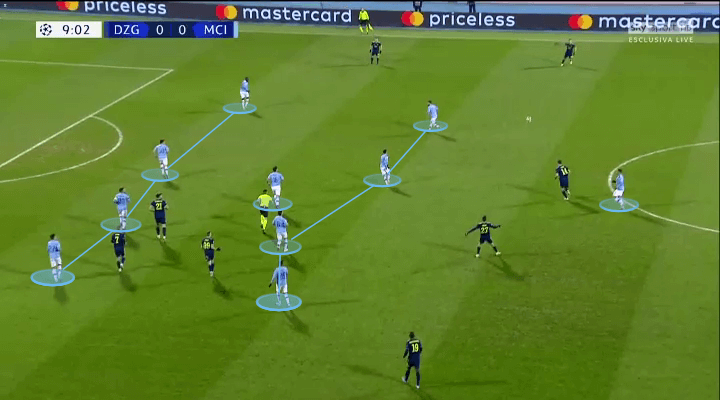
When City were in possession, Zagreb did not press high, in fear of leaving space for City’s rotating midfielders. They allowed the Manchester City centre-backs to have time on the ball, staying close the City options ahead of the ball and pressing as they received it, or appeared to move to receive. Again, the full action of the press and tackle was not committed to in all instances as the Dinamo players were wary of over-committing and being played past on the half-turn, or by a quick pass backwards, allowing space for a progressive pass forwards to a free City player. When in their defensive shape, the team utilised a 4-4-1-1, the same shape as they set up in on paper. Occasionally this turned into a 4-4-2 or a 4-5-1 given the close nature and flexibility of all the discussed formations.
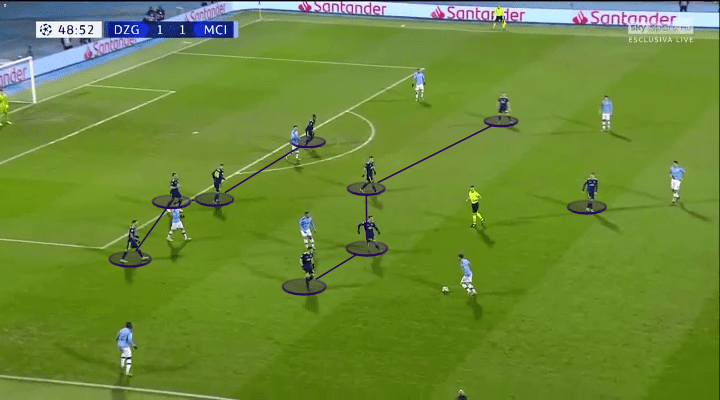
In the first half, in general, Dinamo Zagreb retained their shape well and limited their opponents to few chances. Manchester City controlled the ball and had decent interplay, with Mendy and Joao Cãncelo, high and wide, providing the width around other attacking layers and central midfield players who prefer to play a more central game. Mendy and Cancelo each had numerous attempts at crossing, however, many of these crosses were hopeful, rather than targeted, and Dinamo defenders were happy to deal with high crosses, given no real target man existed for City.
Somewhat ironically, Manchester City equalised via a cross, however, this was after two Dinamo players were down, complaining of injuries. City played on, got bodies in the box and Mahrez had Jesus and other City players lining up on the six-yard box to aim for. After the solid defensive work that Dinamo had done, this was a disappointing outcome for them, as no players for the home side recognised that both Emir Dilaver, the left centre-back and Petar Stojanović, the right-back were down injured in order for them to react and fill in temporarily until the danger had passed.
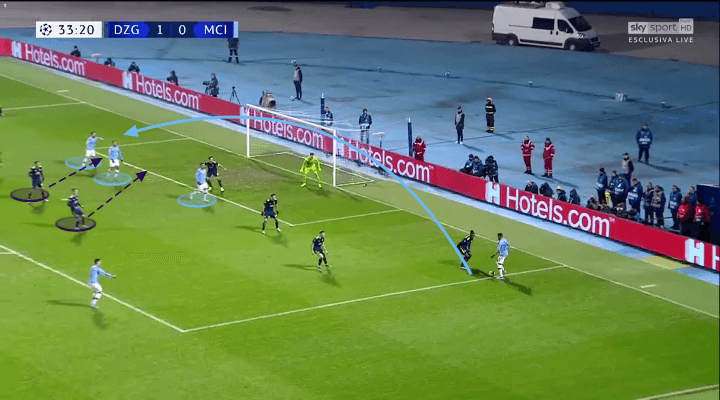
Manchester City’s distinctive shape
Within possession, the away team utilised a combination of split unit shapes, for example, an MW shape with five deeper players positioned in the shape of an M, with a player occupying each point of the W shape, and five or more advanced players positioned slightly different in a W shape. Alternatives to this involved the City units playing in a WW, WM or MM shape depending on the phase of play and the rotation and fluidity within Pep Guardiola’s system.
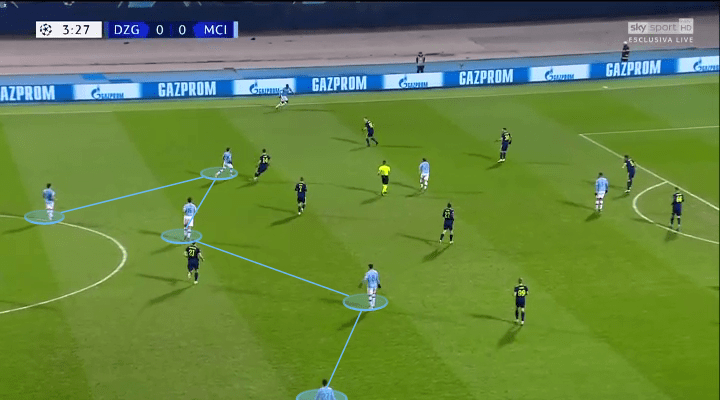
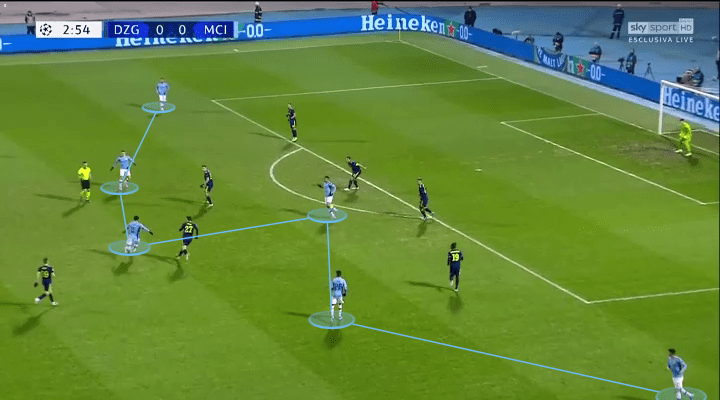
Dinamo drop off
Whilst there was shape retention by Dinamo, within the first half, the defensive line was higher when compared to the second half. As the game developed and City took the lead early in the second half. The Dinamo Zagreb morale fell, they started to drop deeper and deeper, with players pressing in individual bursts, looking demotivated due to the fact they could not win the ball, or retain it when they achieved possession via a rare turnover or the end of a Manchester City attack. The Dinamo formation also changed to more defensive 4-1-4-1.
Within the second half, Manchester City utilised effective combination play down the flanks, taking advantage of the deeper, less compact Dinamo Zagreb. Mendy, Foden and Jesus combined down the left flank, along with other attacking players as movement occurred.
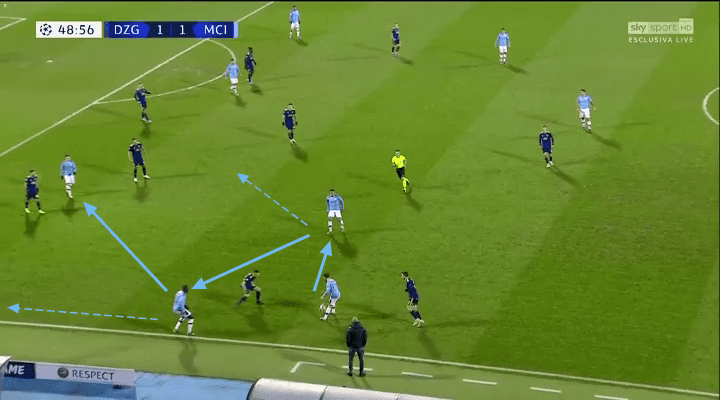
Towards the end of the match, it felt like a training session for Manchester City, who substitutions resulted in multiple positional changes for their team. All players were involved in combination play as they tried to inflict more misery on the Dinamo players, coaches and fans.
Conclusion
Overall, this was an interesting match for the viewers. Dinamo Zagreb took the lead and the atmosphere in the stadium and on the pitch raised as the club started to believe it might be their night. Manchester City went on to control the match but failed to create numerous chances, apart from the equaliser, in the first half. In the second half, Manchester City turned their possession into chances as Jesus scored his second and third goals or the game. As that happened, the realisation sunk in and Dinamo Zagreb struggled for motivation and action to recover. For City, the knock-out stages beckon, for Dinamo, they are out of Europe and must rely on their league form in order to qualify for the preliminary stages of the UEFA Champions League next season.

If you love tactical analysis, then you’ll love the digital magazines from totalfootballanalysis.com – a guaranteed 100+ pages of pure tactical analysis covering topics from the Premier League, Serie A, La Liga, Bundesliga and many, many more. Buy your copy of the December issue for just ₤4.99 here





Comments